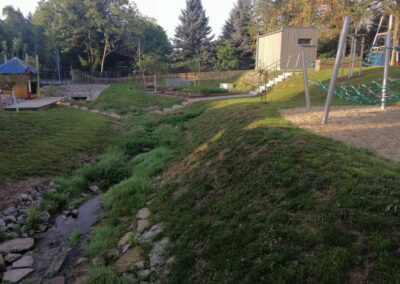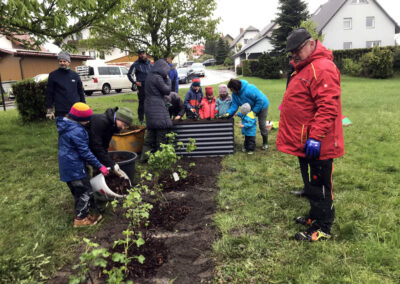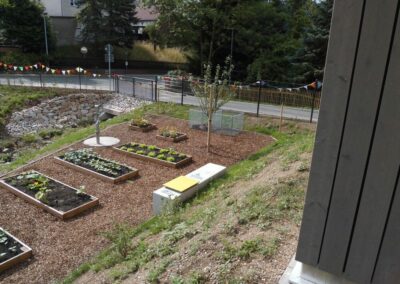Basic info
Country:
Area:
Population:
Density:
Summary:
References:
Keywords
Gallery
"Our successful Children's Municipal Council makes our community special and life in our village worth living and loving."
Issues Addressed
The municipality of Heinsdorfergrund was formed by merging three municipalities, including Hauptmannsgrün, along the Raumbach creek and today has approximately 1,945 inhabitants. Starting in the 1990s, Saxony experienced a wave of elementary school closures due to demographic changes, emigration, and declining student numbers. The municipality fought energetically to preserve its elementary school and received special status with mixed-age classes and free school choice. The high enrolment numbers underscore the high quality of education.
Approaches and Solutions
The elementary school is one of the starting points for development in the community, focusing on children and ecological approaches. Within the school grounds, various ecological aspects that are becoming tangible in rural areas due to advancing climate change were addressed in a small space, such as biodiversity, habitats, creating space for water bodies, rainwater management, as well as aspects of growing fruits and vegetables, using locally typical materials, ensuring mobility, and creating public play areas and meeting points not just for children.
The initially small-scale participatory approach of involving children in schoolyard design has since been expanded to other areas of village development. Along the bicycle path by the Raumbach creek, which is also the school route to Reichenbach for older children, “Nibble Meadows” with berry bushes were created in joint actions by children, teachers, parents, and residents. The meadows that characterize the village landscape are thus being utilized, and not only is the school route becoming more attractive. Another project in planning is the “Village Garden” by the Raumbach, which is intended to develop into a central meeting point for the children’s municipal council.
Actors and Stakeholders
A central element is a unique, now award-winning network consisting of an active elementary school, support association, residents, and the democratically elected Children’s Parliament that has existed since 2023. Of course, such initiatives need a supportive municipal council. For the dedicated mayor Marion Dick, preserving and renovating the elementary school is an important factor for the development and future of the village. After all, what would a village be without children?
Challenges and Opportunities
The preservation of the elementary school, almost impossible under the school network planning conditions at the time, was a major challenge that could only be managed through intensive efforts by the municipal council at the time. Due to limited funding, the renovation of the school could only proceed gradually and is not yet complete.
Outcomes and Lessons Learnt
“Our primary school has developed into a centre of our village community. It forms the foundation for positive demographic development and creates space for ecological projects. It connects young and old.” Marion Dick, Mayor
The children can engage with nature and habitats during their everyday school life and leisure time to develop an understanding for ecology. Habitats for reptiles and insects were created, flower meadows and wild rose hedges were planted, and old apple varieties were cultivated. Green roofs and water-permeable surfaces help reduce peak water runoff into the village stream. The restoration of a creek section reduces flood risk and brings back nature. After school and during holidays, the school grounds are open to all citizens. Additionally, the fire water supply for the upper village was resolved with a large cistern. A barrier-free bus stop was created directly at the school grounds. With Nibble Meadows and the Village Garden, projects were undertaken that combine village community life, participation of the young generation, and ecological design of spaces.
The most important result is that a process has begun in the village that promotes democratic and ecological understanding of the young generation and strengthens their identity with their locality.
Selected major projects and awards
- Designing the outdoor facilities of the primary school – children draw their playground (from 2017)
- Simul+Mitmachfonds – special prize for cooperation: Children’s kitchen project ‘We cook ourselves and eat healthy!’ (2021)
- Naschwiesen am Raumbach – ecologically enhanced worlds of experience, recreation and enjoyment throughout Heinsdorfergrund, nature experience at Raumbach (2023)
- Award in the machen!2023 competition The ideas competition for civic engagement in the eastern German federal states
- Annual rubbish collection by children in the forest, one scoop of ice cream per ½ kg of rubbish (local councillors sponsor the ice cream)
- Village garden (since 2025) – all generations develop and design together, for an area of democratic exchange, coming together and lingering
- Saxon State Prize for Rural Building for the new replacement building for the school (Neumann Architekten, 2021)





